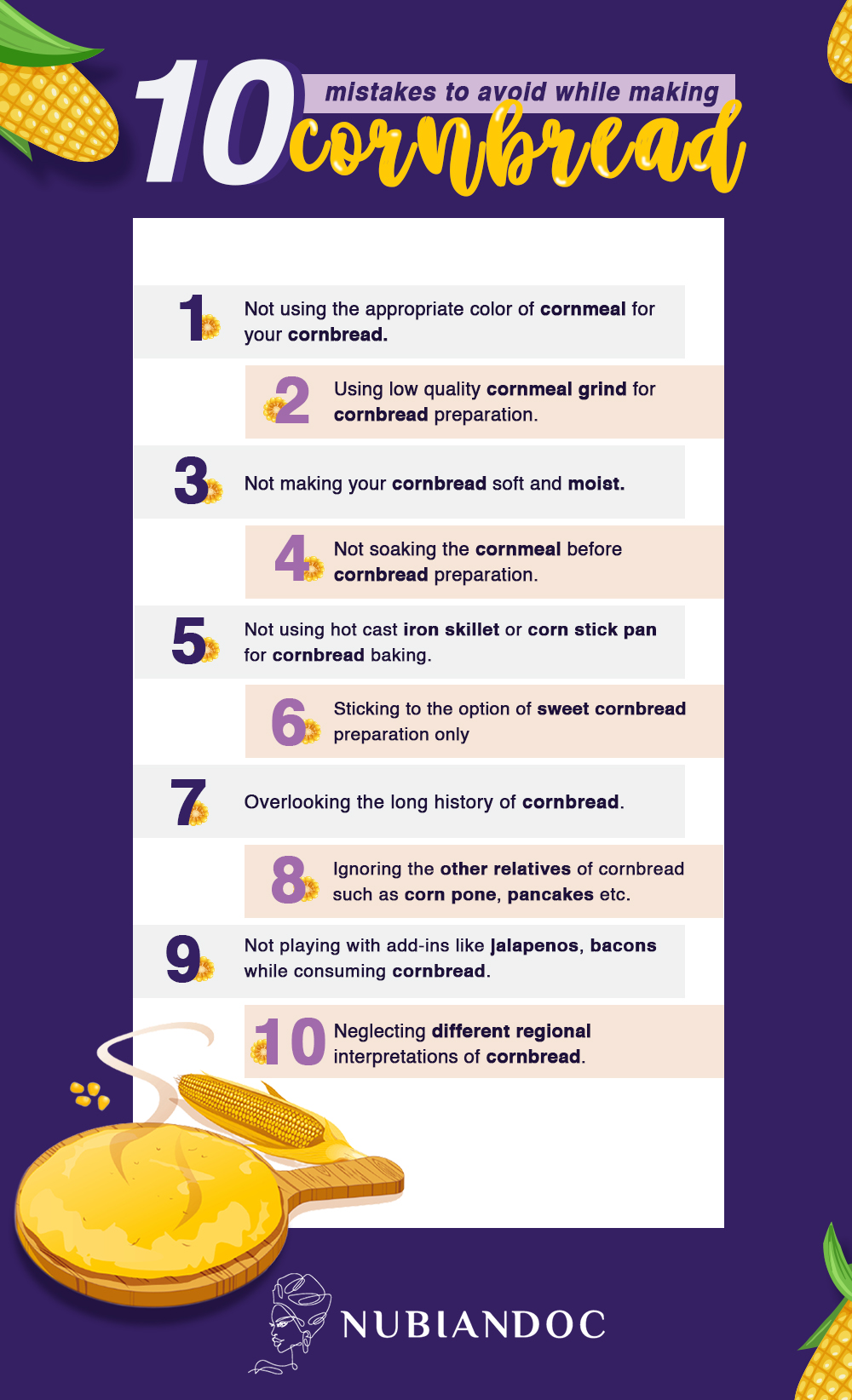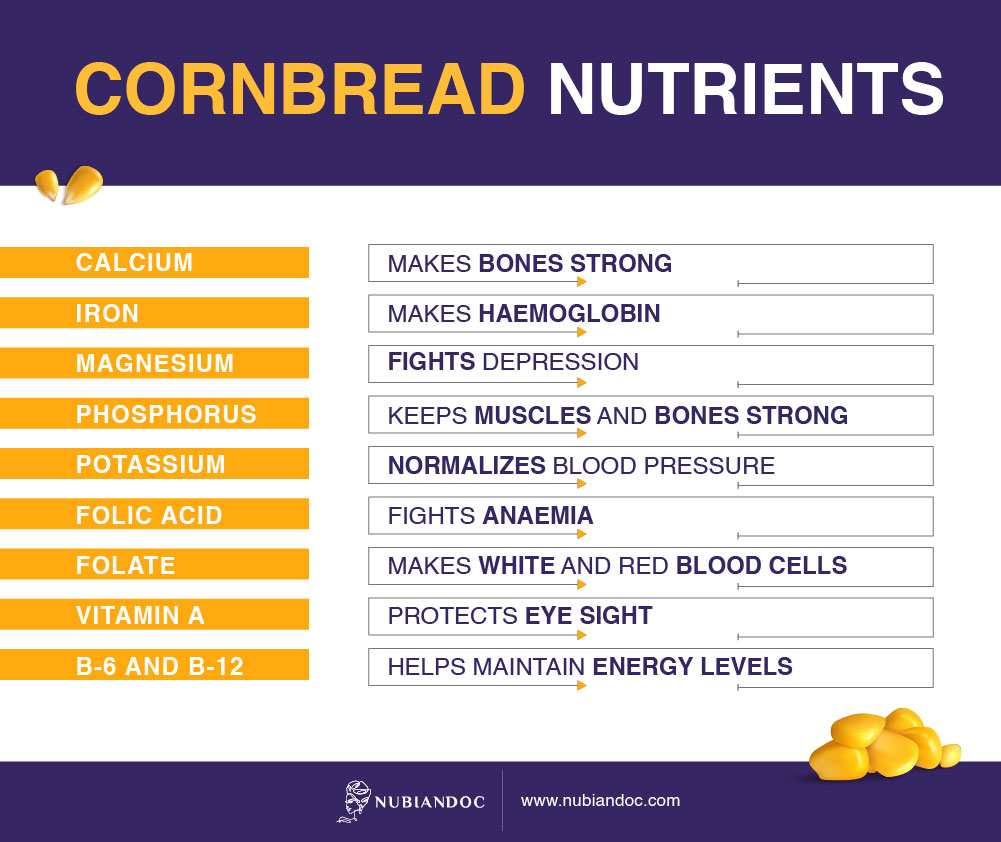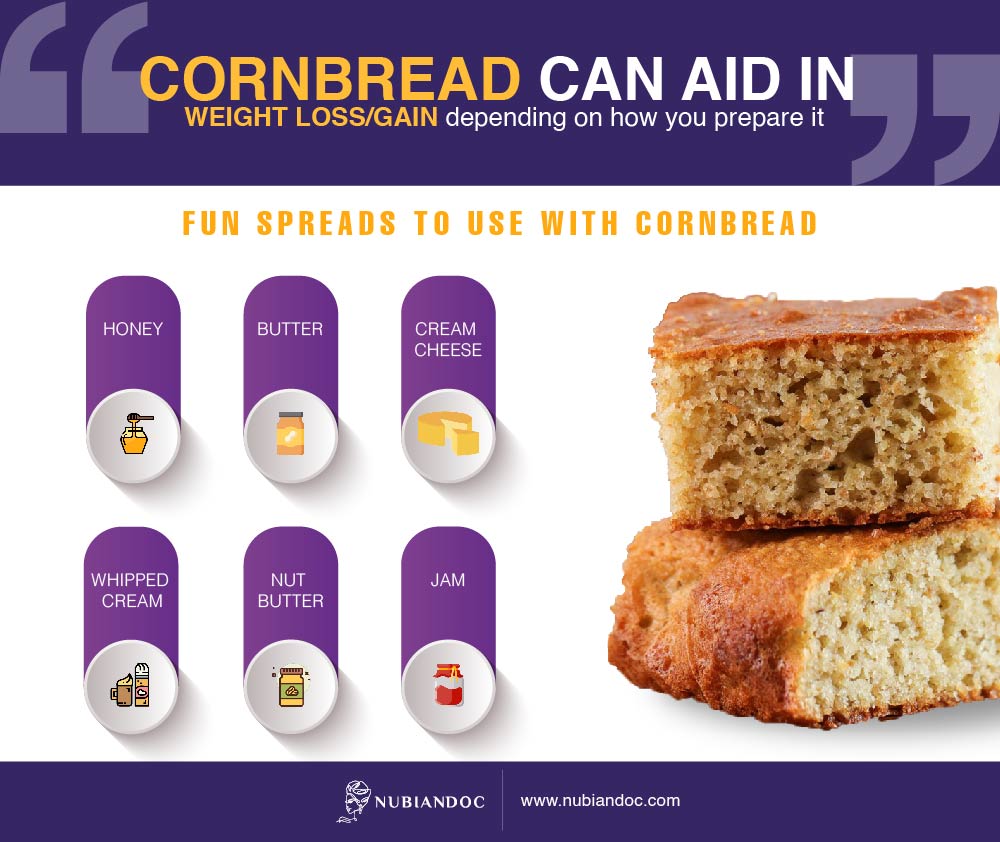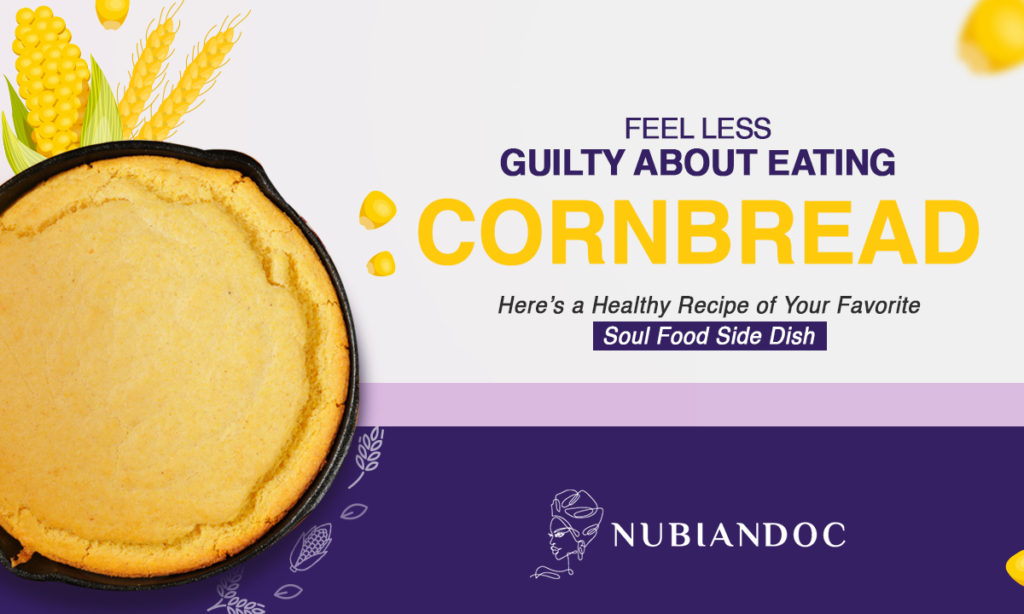History of Cornbread | Cultures & Cornbread | Types & Ways to Serve | Can You Add Sugar? | Health Benefits | Nutritional Composition | Weight Management with Cornbread | Healthy Recipe | Bottom line
Cornbread has long been a staple food of The South. In today’s world, cornbread is prepared in profuse styles, but one thing is still common – the taste! Known for its vibrant color, smooth texture and scrumptious flavor, it is often served alongside a huge variety of dishes. In today’s blog, we’ll be sharing innovative methods of how we can convert this calorie dense food into nutrient dense recipe. Moreover, the nutritional composition of the cornbread and different ways in which you can make it diet friendly, will be discussed.
Where did cornbread originate from? A brief history!
Cornbread has been around for many years and is commonly prepared with the ingredients cornmeal, eggs, milk, and baking soda. Nutrient as well as caloric dense enriched with calcium, magnesium, iron, phosphorus, potassium, folate, and vitamins A, B-6 and B-12, cornbread has been a staple in rural areas and for farmers in Southern America, where it was initially made in the 18th century.
How do different cultures consume cornbread?
Just like Brit knows the finest way to prepare mash potatoes, in United States every other person knows how to prepare scrumptious cornbread. After all, it has a longer history in the country than most modern Americans do have.
Cornbread today is not limited to just America, in fact it has a long history of being used in other continents as well. The British version of cornbread is called corn pone. In India, it is referred as Makai ki roti (flatbread). Johnnycakes (pancakes) and Hushpuppies (fluffy) are some other variations of the southern cornbread. All these may have different shapes and appearances, but the core ingredient (corn meal) remains the same.
Cornbread can be prepared in different styles: high-rising, fluffy loaves, or simply fried, which tastes just divine. Below are some more ways to prepare it:
| CORNBREAD AND DIFFERENT CULTURES | |
| Baked Corn Bean | With the addition of wheat flour, cornmeal, eggs, milk or buttermilk and leavening agent, baked corn beans contribute to the typical northern US cornbread recipe. |
| Corn Pone | Prepared from a thick, malleable cornmeal dough, Corn pone is another variation of cornbread. |
| Hot water Corn bread | Pouring a small amount of liquid batter made with warm water and self-rising cornmeal gives rise to Hot water cornbread |
| Johnnycakes | Johnnycakes is slightly thinner than hot water cornbread and are made by pouring into hot grease skillet to produce a pancake-like bread. |
| Hushpuppies | Hushpuppies are prepared with different spices and seasonings that include onion seasoning, chopped onions and jalapenos mixed with cornmeal |
Summary: Corn is an ancient food that has been around for thousands of years. It has been modified in different forms such as grinding into cornmeal for utilization in different forms including as preparation of cornbread.
Wondering how to serve cornbread? Here you go!
As cornbread itself is a super scrumptious snack, you can devour it on its own, or you can pair it up with soups or any mouthwatering main entrée as well. Usually cornbread is eaten with a spread of honey, butter, apple butter, jam, maple syrup, or cheese. It can also accompany other mouthwatering meals for example deviled eggs, potato salad and creamed corn.
Southern VS. Northern cornbread
One of the distinctions between southern and northern cornbread is that one can be made with white cornmeal and other made with yellow cornmeal.
Northern cornbread gives crumbly texture and uses fewer eggs for its preparation while southern cornbread calls for more eggs to eventually produce cakelike finish and smooth, buttery texture.
Summary: Cornbread has shorter preparation time and is made with cornmeal originated in North American cuisine. It can be served with a number of dishes such as soup or maple syrup. Both Southern and Northern cornbread differ from each other on the base of cornmeal used.
Want to fry cornbread? Here you go!
Often people only use vegetable oil or bacon drippings when frying cornbread to keep things simple.
Sometimes, we use butter and oil together to get the perfect flavor and color. The butter will give a golden-brown color and added flavor whereas the vegetable oil will help elevate the burning temperature of the butter so the cornbread won’t turn brown too fast or burn.
Can you add sugar to your cornbread? – Answering the million-dollar question?
Whether you should add sugar to your cornbread or not? Although the answer is very subjective to taste buds but if we see it with respect to health benefits, the answer is NO!
Adding sugar in cornbread increases the total amount of calories per serving which leads to gain in some unnecessary pounds. Along with that, Sweetened cornbread is not a suitable snack option for diabetic and hypertensive patients.
And in this article, we’ll present a recipe twist that will help you make nutrient dense recipe out of a caloric dense cornbread. At NubianDoc, There are some informative articles that address healthier eating habits. Check out our blog.
Summary: There’s a long-lived debate about whether or not sugar is necessary for cornbread. We suggest it’s really not essential as it will increase the caloric content of food.

Do you know the significant benefits of cornbread? No? Then keep reading!
Cornbread has several nutritional benefits. Some of these benefits are mentioned below:
-
Prevent iron deficiency
Cornbread is a source of iron that helps in promotion of blood health as iron stays in red blood cells called hemoglobin which is necessary to transfer oxygen in the blood from lungs to tissues. Adequate iron intake prevents anemia and issues that come up with that.
-
Lower blood sugar than other processed carbs
Since cornbread is rich in fiber, it helps in maintaining blood sugar levels due to the slow absorption of sugar in the blood.
-
Help in improving digestive health
It regulates bowel movement and lowers the chance of constipation due to the fiber content.
-
Excellent source of Phosphorus
Phosphorus is the second most abundant mineral present in the body and hence it is involved in a large number of body processes. Owing to high phosphorus content of cornbread, it improves bone and teeth health, helps regulate DNA synthesis, body’s optimal pH and energy storage.
Other Health Benefits
Cornbread is a healthy choice of bread and carbs and it comes with numerous other benefits that make it a staple.
- Source of fiber and protein, ensuring you remain full throughout the day and prevent constipation.
- Rich in complex carbohydrates, which break down slowly, giving you energy throughout the day.
- Contains vitamin A, Vitamin A is necessary for the proper functioning of our eyes, kidneys, lungs and heart.
- Source of carotenoids which may help prevent specific types of cancers.
- Low in fat if the right method and recipe is followed.
- Cornbread is a good source of several nutrients such as calcium, iron, magnesium, phosphorus, potassium, folic acid, folates, and vitamins A, B-6, and B-12.
Summary: Cornbread can both be high-caloric or nutrient-dense. It all boils down to what ingredients and recipes you use to prepare the meal. However, if you add sugar, oil or butter to your recipe, get ready to gain a few pounds rather than losing them. Our “sugar-free cornbread recipe” given below will ensure you multiple health benefits from the cornmeal.
Nutritional Composition of Cornbread
Recipe: Cornbread made with yellow cornmeal soaked in water (Homemade) without any add-ins
Serving size: 1 Piece
Serving weight: 65g
| Nutrient | Value |
| Calories | 172.9 |
| Total Carbs | 28.3g |
| Sugar | – |
| Starch | – |
| Fiber | – |
| Sugar Alcohol | – |
| Proteins | 4.4g |
| Fat | 4.6g |
| Monounsaturated fat | 1.2g |
| Polyunsaturated fat | 2.1g |
| Saturated fat | 1g |
| Cholesterol | 26mg |
| Calcium | 161.9mg |
| Iron | 1.6mg |
| Magnesium | 16.3mg |
| Phosphorus | 109.9mg |
| Potassium | 95.6mg |
| Zinc | 0.4mg |
| Copper | 0mg |
| Selenium | 6.6mcg |
| Folate | 50.1mcg |
| Vitamin A | 54mcg |
| Vitamin B1 | 0.2mg |
| Vitamin B2 | 0.2mg |
| Vitamin B3 | 1.5mg |
| Vitamin B6 | 0.1mg |
| Vitamin B12 | 0.1mcg |
| Vitamin C | 0.2mg |
| Vitamin D | 0mcg |

How can cornbread help with weight management?
Any food prepared and consumed with portion control taken into account will help in weight control. For example, a slice of the cornbread (prepared with our recipe) comes with less than 100 calories.
- The most important reason why it will help eliminate the cholesterol if you consume cornbread is cornmeal; which is the primary ingredient of any form of cornbread. Cornmeal is rich in fiber. It is also a whole grain containing bran. Owing to high fiber content, you will naturally eat less and consume less calories.
- The second reason to consume whole grains such as cornmeal is that they are slow-burning carbs that give you a feeling of fullness and satiety for more extended period, and as a result, you will end up consuming fewer calories per day.
Summary: The essential ingredient of cornbread is cornmeal with tons of fiber that helps in improving digestive health and weight management. Apart from that, cornmeal is high in antioxidants that helps it improve energy metabolism.

A healthy cornbread recipe!
Finally, let us check out the cornbread recipe that promises a healthy intake of nutrients if you eat it the right
way.
This recipe has no oil and sugar.
Servings Prep Time Cook Time Serves
12 people 10 minutes 45 minutes Four
Ingredients
- 1 pound corn grits
- 1/4 cup flour (stoneground whole-wheat)
- Two teaspoons baking powder
- 1/4 teaspoon cinnamon ground
- 1/4 teaspoon nutmeg ground
- Two teaspoons Splenda optional
- 2 cups milk soy or skim
- Two teaspoons vanilla extract
- 4 egg whites
Instructions
- Preheat oven to 350 degrees F.
- Place all the dry ingredients in a bowl and mix well. Make a hole in the center and
pour in milk and vanilla. Use a wire and whisk to mix in the liquids with a circular
motion gently. - In a separate bowl, whip egg whites until fluffy. Pour into the mixture and mix in.
- Pour mixture into a non-stick pan, and bake at 350 degrees for 27 to 29 minutes.
- Allow the cornbread to cool in the pan for about 10 minutes.
Summary: Cornbread is an excellent source of a variety of vitamins and minerals and should be consumed in moderation. Therefore, cornbread is a perfect alternative to white bread in your daily meals. The sugar-free recipe we added in the article is an ideal way to prepare cornbread in a healthier way.
How can we add cornbread to our meals?
Cornbread has been a staple for thousands of years and is consumed differently in different cultures. It itself is a scrumptious snack to devour, however it can be used as a side with some dishes like;
- Vegetable stew/ soup
- Sauteed veggies
- Fried chicken
- Milk
- BBQ
- Beef stew
The Bottom Line
Cornbread is a staple dish and is especially popular amongst southerners. It contains numerous health benefits because of its core ingredient cornmeal. Rich in Calcium, Iron and Fiber, cornbread has a nutritional profile for consideration. This light and textured bread smells heavenly when it comes out of the oven and it can be enjoyed with soups, greens or spreads and well with many different foods. No matter how can be prepared, or if it is savory or sweet in taste, one thing is for sure, cornbread is for all!
In the given recipe, we have skipped sugar and excess oil to make sure that you get maximum health benefits from its consumption by avoiding extra calories.
If you want to lose weight with a healthy diet, NubianDoc is here for you. With our customized meal plan and workout exercises, you are sure to be on the right track towards your weight loss goals. Contact us now.
Also, check out our informative articles for guidance on health and well-being.
Is cornbread better than bread?
White bread is high in calories and yellow corn has 60% less calories than white bread - white bread has 238 calories per 100 grams and yellow corn has 96 calories.
How to know if the cornbread is stale or unsafe for use?
The cornbread has gone stale if you notice mold, discoloration, it smells sour, or it has gotten soggy and chewy.
Is cornbread safe for a diabetic person?
Diabetic people need to count their carbohydrates for the simple reason that carbohydrate consumption correlates with blood sugar levels. So they need to keep their carbohydrate intake limited. However, cornbread contains a number of vitamins and minerals and people with diabetes can eat it in moderation, taking care of how well controlled their diabetes sugar control is.


